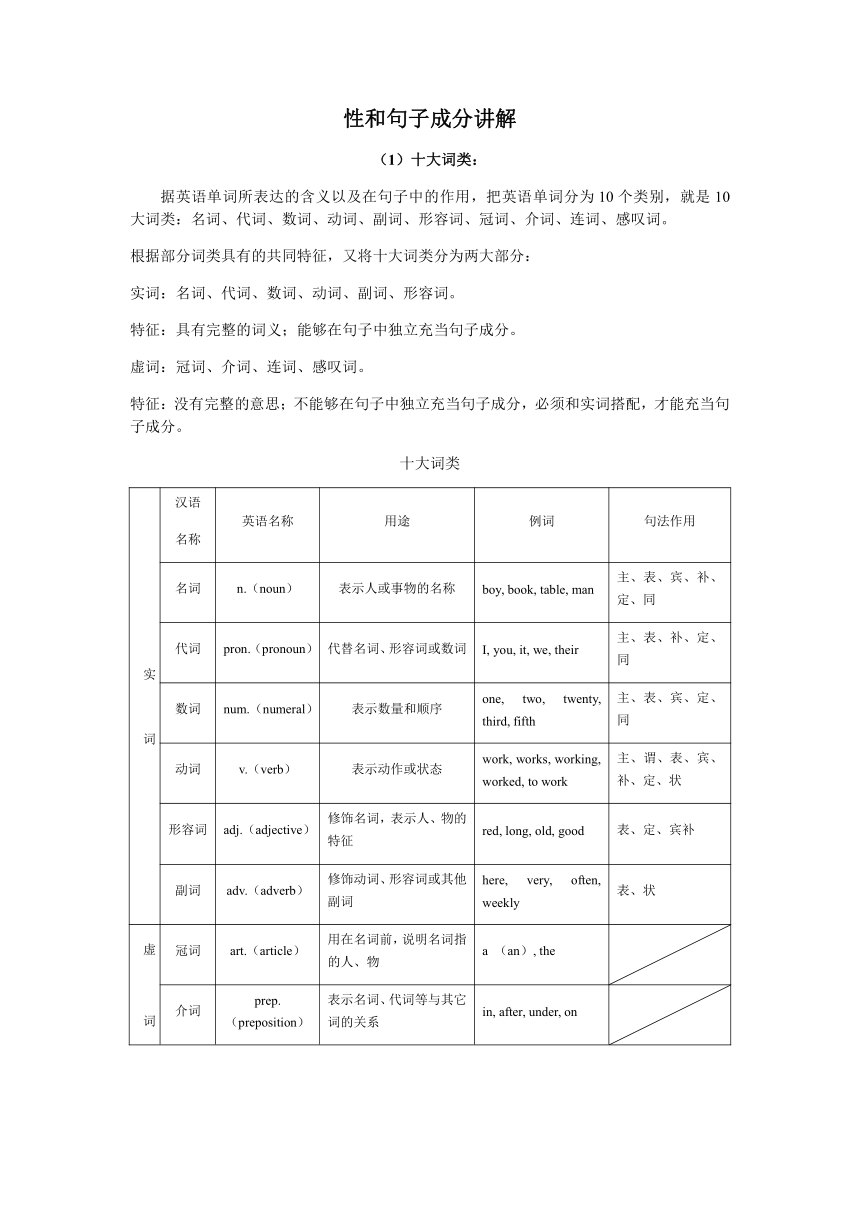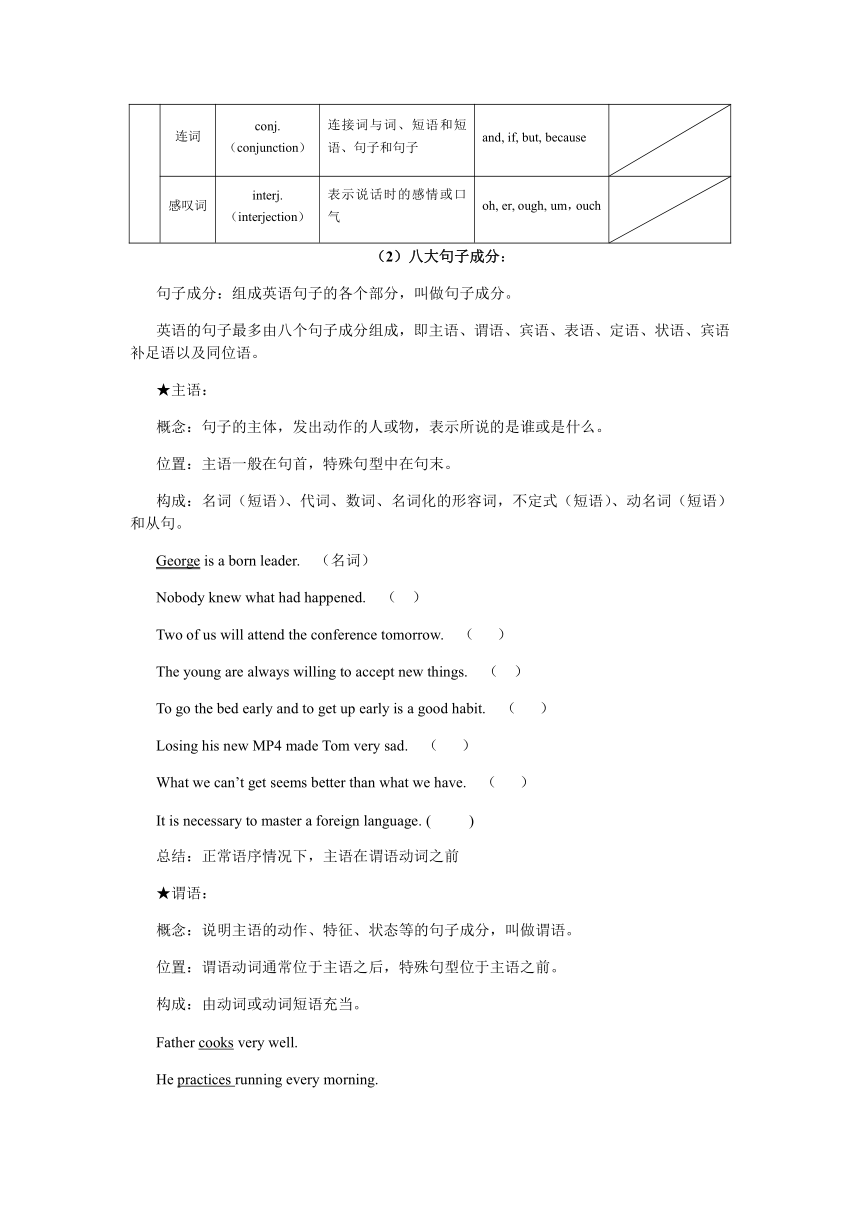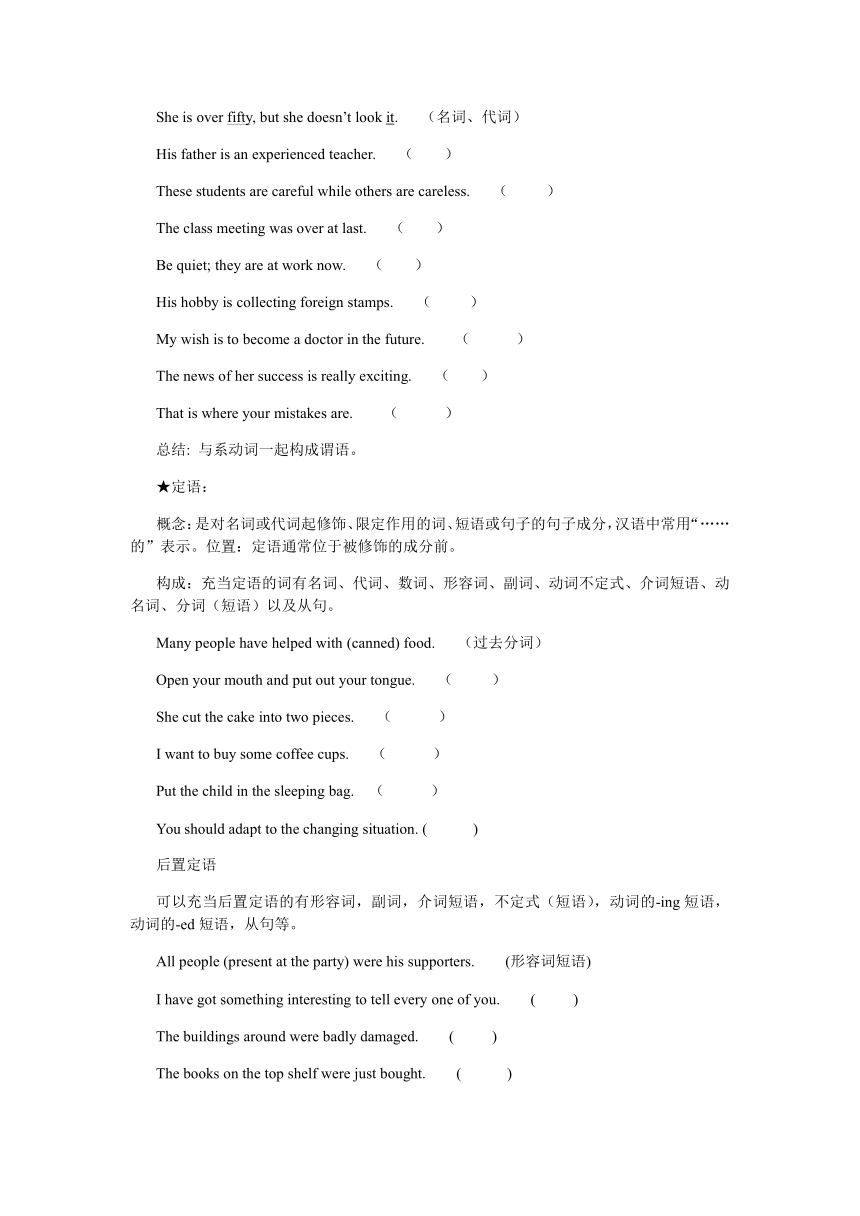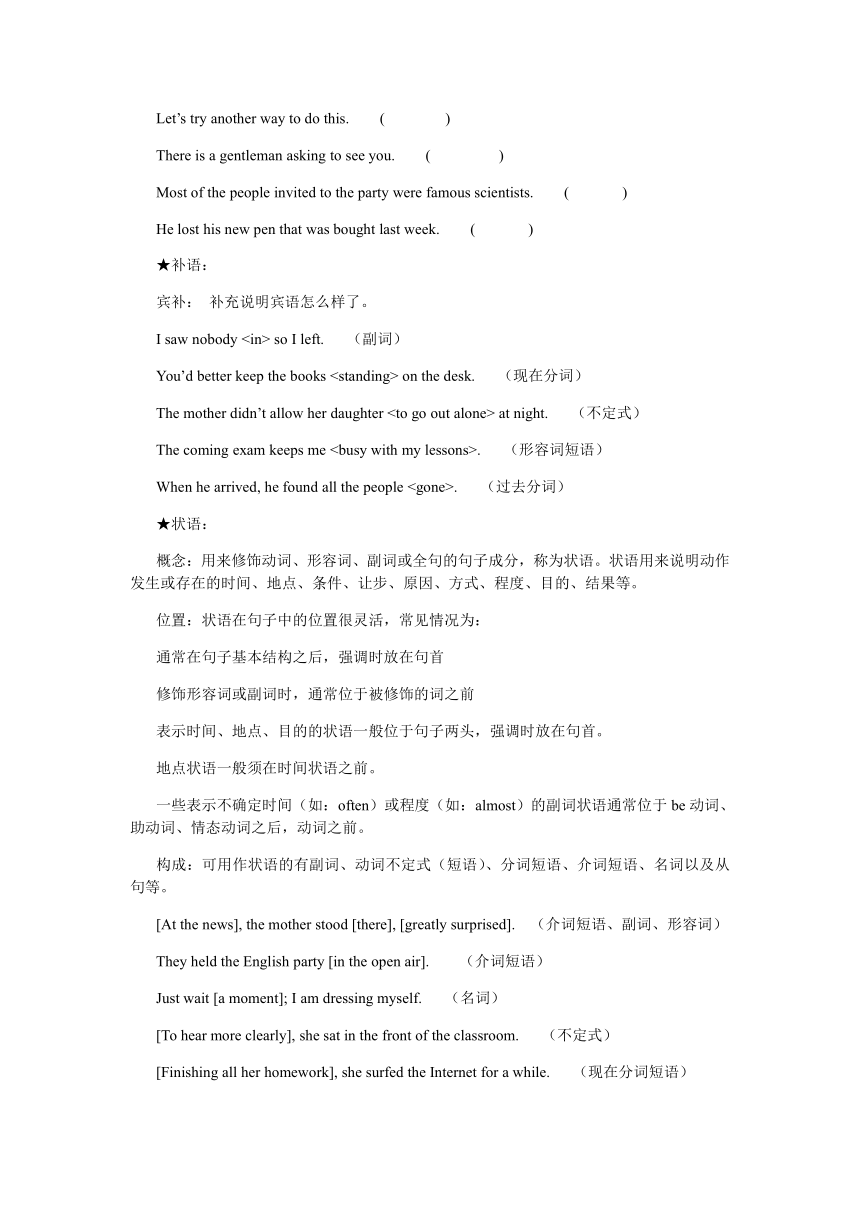2022届高考英语三轮考前冲刺之词性、句子分析练习讲义
文档属性
| 名称 | 2022届高考英语三轮考前冲刺之词性、句子分析练习讲义 |  | |
| 格式 | docx | ||
| 文件大小 | 34.2KB | ||
| 资源类型 | 教案 | ||
| 版本资源 | 通用版 | ||
| 科目 | 英语 | ||
| 更新时间 | 2022-05-04 11:23:46 | ||
图片预览





文档简介
性和句子成分讲解
(1)十大词类:
据英语单词所表达的含义以及在句子中的作用,把英语单词分为10个类别,就是10大词类:名词、代词、数词、动词、副词、形容词、冠词、介词、连词、感叹词。
根据部分词类具有的共同特征,又将十大词类分为两大部分:
实词:名词、代词、数词、动词、副词、形容词。
特征:具有完整的词义;能够在句子中独立充当句子成分。
虚词:冠词、介词、连词、感叹词。
特征:没有完整的意思;不能够在句子中独立充当句子成分,必须和实词搭配,才能充当句子成分。
十大词类
实 词 汉语 名称 英语名称 用途 例词 句法作用
名词 n.(noun) 表示人或事物的名称 boy, book, table, man 主、表、宾、补、定、同
代词 pron.(pronoun) 代替名词、形容词或数词 I, you, it, we, their 主、表、补、定、同
数词 num.(numeral) 表示数量和顺序 one, two, twenty, third, fifth 主、表、宾、定、同
动词 v.(verb) 表示动作或状态 work, works, working, worked, to work 主、谓、表、宾、补、定、状
形容词 adj.(adjective) 修饰名词,表示人、物的特征 red, long, old, good 表、定、宾补
副词 adv.(adverb) 修饰动词、形容词或其他副词 here, very, often, weekly 表、状
虚 词 冠词 art.(article) 用在名词前,说明名词指的人、物 a (an), the
介词 prep.(preposition) 表示名词、代词等与其它词的关系 in, after, under, on
连词 conj.(conjunction) 连接词与词、短语和短语、句子和句子 and, if, but, because
感叹词 interj.(interjection) 表示说话时的感情或口气 oh, er, ough, um,ouch
(2)八大句子成分:
句子成分:组成英语句子的各个部分,叫做句子成分。
英语的句子最多由八个句子成分组成,即主语、谓语、宾语、表语、定语、状语、宾语补足语以及同位语。
★主语:
概念:句子的主体,发出动作的人或物,表示所说的是谁或是什么。
位置:主语一般在句首,特殊句型中在句末。
构成:名词(短语)、代词、数词、名词化的形容词,不定式(短语)、动名词(短语)和从句。
George is a born leader. (名词)
Nobody knew what had happened. ( )
Two of us will attend the conference tomorrow. ( )
The young are always willing to accept new things. ( )
To go the bed early and to get up early is a good habit. ( )
Losing his new MP4 made Tom very sad. ( )
What we can’t get seems better than what we have. ( )
It is necessary to master a foreign language. ( )
总结:正常语序情况下,主语在谓语动词之前
★谓语:
概念:说明主语的动作、特征、状态等的句子成分,叫做谓语。
位置:谓语动词通常位于主语之后,特殊句型位于主语之前。
构成:由动词或动词短语充当。
Father cooks very well.
He practices running every morning.
复合谓语:由情态动词或其他助动词加动词原形构成。
My sister has worked in the company for five years.
You may keep the book for two weeks.
总结: 谓语部分由动词,动词短语或系表结构构成。
★宾语:
概念:动词宾语是动作的承受者。及物动词以及相当于及物动词的短语后都必须带宾语。
介词之后的宾语叫介词宾语。
位置:动词宾语位于及物动词之后;介词宾语位于介词之后。
构成:名词、名词化的形容词、代词、数词、-ing形式、动词不定式和从句等均可作宾语。
I can hardly hear the radio. Would you please turn it up (名词、代词)
If you put 5 and 7 together, you’ll get 12, little Tom. ( )
We should help the poor. ( )
Remember to tell him to come. ( )
Please stop making noise. ( )
Do you understand what I mean ( )
双宾语:
英语中,有些及物动词可以接两个宾语,动作的承受者,即指物的叫做直接宾语,动作是为谁做的或是对谁做的,即指人的叫做间接宾语,这两个宾语称为“双宾语”。
Please tell me how the accident came about.
The teacher asked me a question too difficult to answer.
双宾的动词是有范围的,一般放在以下动词之后:
give, show, send, bring, offer, read, pass, lend, leave, hand, tell, return, write, pay, throw, allow, wish, teach, promise等。
★表语:
概念:用来说明主语的身份、特征、状态等的句子成分,是表语。
位置:位于联系动词之后,与联系动词构成复合谓语。
构成:可作表语的有名词、代词、形容词、数词、副词、动词不定式、介词短语、分词短语以及从句等。
She is over fifty, but she doesn’t look it. (名词、代词)
His father is an experienced teacher. ( )
These students are careful while others are careless. ( )
The class meeting was over at last. ( )
Be quiet; they are at work now. ( )
His hobby is collecting foreign stamps. ( )
My wish is to become a doctor in the future. ( )
The news of her success is really exciting. ( )
That is where your mistakes are. ( )
总结: 与系动词一起构成谓语。
★定语:
概念:是对名词或代词起修饰、限定作用的词、短语或句子的句子成分,汉语中常用“……的”表示。位置:定语通常位于被修饰的成分前。
构成:充当定语的词有名词、代词、数词、形容词、副词、动词不定式、介词短语、动名词、分词(短语)以及从句。
Many people have helped with (canned) food. (过去分词)
Open your mouth and put out your tongue. ( )
She cut the cake into two pieces. ( )
I want to buy some coffee cups. ( )
Put the child in the sleeping bag. ( )
You should adapt to the changing situation. ( )
后置定语
可以充当后置定语的有形容词,副词,介词短语,不定式(短语),动词的-ing短语,动词的-ed短语,从句等。
All people (present at the party) were his supporters. (形容词短语)
I have got something interesting to tell every one of you. ( )
The buildings around were badly damaged. ( )
The books on the top shelf were just bought. ( )
Let’s try another way to do this. ( )
There is a gentleman asking to see you. ( )
Most of the people invited to the party were famous scientists. ( )
He lost his new pen that was bought last week. ( )
★补语:
宾补: 补充说明宾语怎么样了。
I saw nobody so I left. (副词)
You’d better keep the books on the desk. (现在分词)
The mother didn’t allow her daughter at night. (不定式)
The coming exam keeps me. (形容词短语)
When he arrived, he found all the people. (过去分词)
★状语:
概念:用来修饰动词、形容词、副词或全句的句子成分,称为状语。状语用来说明动作发生或存在的时间、地点、条件、让步、原因、方式、程度、目的、结果等。
位置:状语在句子中的位置很灵活,常见情况为:
通常在句子基本结构之后,强调时放在句首
修饰形容词或副词时,通常位于被修饰的词之前
表示时间、地点、目的的状语一般位于句子两头,强调时放在句首。
地点状语一般须在时间状语之前。
一些表示不确定时间(如:often)或程度(如:almost)的副词状语通常位于be动词、助动词、情态动词之后,动词之前。
构成:可用作状语的有副词、动词不定式(短语)、分词短语、介词短语、名词以及从句等。
[At the news], the mother stood [there], [greatly surprised]. (介词短语、副词、形容词)
They held the English party [in the open air]. (介词短语)
Just wait [a moment]; I am dressing myself. (名词)
[To hear more clearly], she sat in the front of the classroom. (不定式)
[Finishing all her homework], she surfed the Internet for a while. (现在分词短语)
[Seen from the top of the hill], the small city looks more beautiful. (过去分词短语)
Don’t leave here [until you work out the math problem]. (时间状语从句)
★同位语:
概念:同位语是在名词或代词之后并列另一个名词或代词,对前者加以解释或说明的句子成分。它近乎于后置定语,对前面的名词或代词作进一步的解释说明的作用,说明前面的词是“谁”、是“什么”等。
位置:位于所补充说明的词之前或之后。
构成:同位语通常由名词、数词、代词或从句担当。
同位语与定语的区别:同位语是对前面的名词或代词作进一步的解释、说明的作用,说明前面的词是“谁”、是“什么”等;而定语则是对被修饰的词起限制或修饰的作用。
(3)、五种基本句型
英语句子的基本结构可以归纳成五种基本句型及其扩大、组合、省略或倒装。掌握这五种基本句型,是掌握各种英语句子结构的基础。
英语五种基本句型列式如下:
一、 S V (主+谓)
二、 S V P (主+系+表)
三、 S V O (主+谓+宾)
四、 S V o O (主+谓+间宾+直宾)
五、 S V O C (主+谓+宾+宾补)
基本句型 一:S V (主+谓)
1. The sun │was shining. 太阳在照耀着。
2. The moon │rose. 月亮升起了。
3. The universe │remains. 宇宙长存。
基本句型 二: S V P (主+系+表)
此句型的句子有一个共同的特点:句子谓语动词都不能表达一个完整的意思,必须加上一个表明主语身份或状态的表语构成复合谓语,才能表达完整的意思。这类动词叫做连系动词。系动词分两类:be, look, keep, seem等属一类,表示情况;get, grow, become, turn等属另一类,表示变化。be 本身没有什么意义,只起连系主语和表语的作用。其它系动词仍保持其部分词义。感官动词多可用作联系动词:look well/面色好,sound nice/听起来不错,feel good/感觉好,smell bad/难闻
1. This │is │an English-Chinese dictionary. 这是本英汉辞典。
2. The dinner │smells │good. 午餐的气味很好。
3. He │fell │in love. 他堕入了情网。
基本句型 三: S V O (主+谓+宾)
此句型句子的共同特点是:谓语动词都具有实义,都是主语产生的动作,但不能表达完整的意思,必须跟有一个宾语,即动作的承受者,才能使意思完整。这类动词叫做及物动词。宾语位于及物动词之后,一般同主语构成一样,不同的是构成宾语的代词必须是‘代词宾格’,如:me,him,them等
1. Who │knows │the answer 谁知道答案?
2. She │smiled │her thanks. 她微笑表示感谢。
3. He │has refused │to help them. 他拒绝帮他们。
基本句型 四: S V o O (主+谓+间宾+直宾)
有些及物动词可以有两个宾语,如:give给,pass递,bring带,show显示。这两个宾语通常一个指人,为间接宾语;一个指物,为直接宾语。间接宾语一般位于直接宾语之前。 一般的顺序为:动词 + 间接宾语 + 直接宾语。
1. She │ordered │herself │a new dress. 她给自己定了一套新衣裳。
2. She │cooked │her husband │a delicious meal. 她给丈夫煮了一顿美餐。
3. He │brought │you │a dictionary. 他给你带来了一本字典。
基本句型 五: S V O C (主+谓+宾+宾补)
此句型的句子的共同特点是:动词虽然是及物动词,但是只跟一个宾语还不能表达完整的意思,必须加上一个补充成分来补足宾语,才能使意思完整。
名词/代词宾格 + 名词
The war made him a soldier. 战争使他成为一名战士.
名词/代词宾格 + 形容词
New methods make the job easy. 新方法使这项工作变得轻松.
S │V(及物)│ O(宾语) │ C(宾补)
1. They │appointed │him │manager. 他们任命他当经理。
2. They │painted │the door │green. 他们把门漆成绿色
3. This │set │them │thinking. 这使得他们要细想一想。
(4)句子的分类
1、按句子的用途可分四种:
1)陈述句(肯定、否定):He is six years old; She didn’t hear of you before.
2)疑问句(一般、特殊、选择、反意):Do they like skating How old is he Is he six or seven years old Mary can swim, can’t she
3)祈使句:Be careful, boys; Don’t talk in class
4)感叹句:How clever the boy is!
2、按句子的结构可分三种:
1)简单句:只有一个主语(或并列主语)和一个谓语(或并列谓语)。
e.g. He often reads English in the morning.
Tom and Mike are American boys.
She likes drawing and often draws pictures for the wall newspapers.
2) 并列句:由并列连词(and, but, or等)或分号(;)把两个或两个以上的简单句连在一起构成。
e.g. You help him and he helps you.
The future is bright; the road is tortuous. 前途是光明的,道路是曲折的。
3)复合句:含有一个或一个以上从句的句子。复合句包含:名词性从句(主语从句、宾语从句、表语从句和同位语从句)、定语从句和状语从句等。
(
题型特训
)e.g. The foreign visitors took a lot of pictures when they were at the Great Wall.
画出句子的主要成分
1. Whether we’ll go depend on the weather.
2. People’s standards of living are going up steadily.
3. That was how they were defeated.
4. The nursery takes good care of our children.
5. I’ll return the book to you tomorrow.
6. We are sure that we shall succeed.
7. The woman with a baby in her arms is his other.
8. There are many films that I’d like to see.
9. Have you met the person about whom he was speaking
10.I have a lot of work to do.
11.Anyway I won’t stop you from doing it.
12.I said it in fun.
13.We can send a car over to fetch you.
14.She had to work standing up.
15.Seeing this, some comrades became very worried.
16.Much interested, he agreed to give it a try.
17.The bus arrived ten minutes late.
18.We should serve the people heart and soul.
19.Spring coming on, the tree turned green.
20.Some farmers saw something strange in the sky.
(5)长难句分析
看看下面句子的修饰成分
After chatting with Laura on this matter for two hours from 2:00 to 4:00 in the afternoon, I returned to my office.
介词短语正是让英语句子变得又长又难的原因之一!
尽管这些修饰成分数量很多、位置也不好把握,但是,它们的种类却是非常固定的。我们可以将这些修饰成分总结为“三长两短”。
“三长”:就是构成长难句的三种较长修饰成分(即介词短语、从句、非谓语动词短语);
“两短”:指的是镶嵌于句子之中的、会稍稍提高句子复杂度的两种较短修饰成分(即形容词、副词)。
(
题型特训
)“平行并列结构”:是由一些并列关系的连词 (and、or、as well as等) 将句子变长的重要手段。
1. And there are the townsfolk who largely live off the tourists who come, not to see the plays, but to look at Anne Hathaways Cottage, Shakespeares birthplace and the other sights.
2. It is the playgoers, who bring in much of the towns revenue because they spend the night (some of them four or five nights) pouring cash into the hotels and restaurants.
4.In a more recent study, Berninger looked at what role spelling plays in a student's writing skills and found that how well children spell is tied to how well they can write.
5. Their methods do not attempt to estimate the actual biomass (the amount of living biological matter) of fish species in particular parts of the ocean, but rather changes in that biomass(生物量)over time.
3.Surely we're still better off than those who wear rags and sleep on the streets or in vacant buildings, but there is a growing resistance(n.抵制) to this consuming society which is especially affecting the youth today with their computers, i-pads, designer clothes and mobile phones.
6. The notion is that people have failed to detect the massive changes which have happened in the ocean because they have been looking back only a relatively short time into the past.
7. This crocodile(鳄鱼) moves very quickly when it sees something it considers to be food, and from time to time a crocodile has snatched someone before he or she is even aware that the crocodile is there.
9. Many things make people think artists are weird. But the weirdest may be this: artist's only job is to explore emotions, and yet they choose to focus on the ones that feel bad.
(1)十大词类:
据英语单词所表达的含义以及在句子中的作用,把英语单词分为10个类别,就是10大词类:名词、代词、数词、动词、副词、形容词、冠词、介词、连词、感叹词。
根据部分词类具有的共同特征,又将十大词类分为两大部分:
实词:名词、代词、数词、动词、副词、形容词。
特征:具有完整的词义;能够在句子中独立充当句子成分。
虚词:冠词、介词、连词、感叹词。
特征:没有完整的意思;不能够在句子中独立充当句子成分,必须和实词搭配,才能充当句子成分。
十大词类
实 词 汉语 名称 英语名称 用途 例词 句法作用
名词 n.(noun) 表示人或事物的名称 boy, book, table, man 主、表、宾、补、定、同
代词 pron.(pronoun) 代替名词、形容词或数词 I, you, it, we, their 主、表、补、定、同
数词 num.(numeral) 表示数量和顺序 one, two, twenty, third, fifth 主、表、宾、定、同
动词 v.(verb) 表示动作或状态 work, works, working, worked, to work 主、谓、表、宾、补、定、状
形容词 adj.(adjective) 修饰名词,表示人、物的特征 red, long, old, good 表、定、宾补
副词 adv.(adverb) 修饰动词、形容词或其他副词 here, very, often, weekly 表、状
虚 词 冠词 art.(article) 用在名词前,说明名词指的人、物 a (an), the
介词 prep.(preposition) 表示名词、代词等与其它词的关系 in, after, under, on
连词 conj.(conjunction) 连接词与词、短语和短语、句子和句子 and, if, but, because
感叹词 interj.(interjection) 表示说话时的感情或口气 oh, er, ough, um,ouch
(2)八大句子成分:
句子成分:组成英语句子的各个部分,叫做句子成分。
英语的句子最多由八个句子成分组成,即主语、谓语、宾语、表语、定语、状语、宾语补足语以及同位语。
★主语:
概念:句子的主体,发出动作的人或物,表示所说的是谁或是什么。
位置:主语一般在句首,特殊句型中在句末。
构成:名词(短语)、代词、数词、名词化的形容词,不定式(短语)、动名词(短语)和从句。
George is a born leader. (名词)
Nobody knew what had happened. ( )
Two of us will attend the conference tomorrow. ( )
The young are always willing to accept new things. ( )
To go the bed early and to get up early is a good habit. ( )
Losing his new MP4 made Tom very sad. ( )
What we can’t get seems better than what we have. ( )
It is necessary to master a foreign language. ( )
总结:正常语序情况下,主语在谓语动词之前
★谓语:
概念:说明主语的动作、特征、状态等的句子成分,叫做谓语。
位置:谓语动词通常位于主语之后,特殊句型位于主语之前。
构成:由动词或动词短语充当。
Father cooks very well.
He practices running every morning.
复合谓语:由情态动词或其他助动词加动词原形构成。
My sister has worked in the company for five years.
You may keep the book for two weeks.
总结: 谓语部分由动词,动词短语或系表结构构成。
★宾语:
概念:动词宾语是动作的承受者。及物动词以及相当于及物动词的短语后都必须带宾语。
介词之后的宾语叫介词宾语。
位置:动词宾语位于及物动词之后;介词宾语位于介词之后。
构成:名词、名词化的形容词、代词、数词、-ing形式、动词不定式和从句等均可作宾语。
I can hardly hear the radio. Would you please turn it up (名词、代词)
If you put 5 and 7 together, you’ll get 12, little Tom. ( )
We should help the poor. ( )
Remember to tell him to come. ( )
Please stop making noise. ( )
Do you understand what I mean ( )
双宾语:
英语中,有些及物动词可以接两个宾语,动作的承受者,即指物的叫做直接宾语,动作是为谁做的或是对谁做的,即指人的叫做间接宾语,这两个宾语称为“双宾语”。
Please tell me how the accident came about.
The teacher asked me a question too difficult to answer.
双宾的动词是有范围的,一般放在以下动词之后:
give, show, send, bring, offer, read, pass, lend, leave, hand, tell, return, write, pay, throw, allow, wish, teach, promise等。
★表语:
概念:用来说明主语的身份、特征、状态等的句子成分,是表语。
位置:位于联系动词之后,与联系动词构成复合谓语。
构成:可作表语的有名词、代词、形容词、数词、副词、动词不定式、介词短语、分词短语以及从句等。
She is over fifty, but she doesn’t look it. (名词、代词)
His father is an experienced teacher. ( )
These students are careful while others are careless. ( )
The class meeting was over at last. ( )
Be quiet; they are at work now. ( )
His hobby is collecting foreign stamps. ( )
My wish is to become a doctor in the future. ( )
The news of her success is really exciting. ( )
That is where your mistakes are. ( )
总结: 与系动词一起构成谓语。
★定语:
概念:是对名词或代词起修饰、限定作用的词、短语或句子的句子成分,汉语中常用“……的”表示。位置:定语通常位于被修饰的成分前。
构成:充当定语的词有名词、代词、数词、形容词、副词、动词不定式、介词短语、动名词、分词(短语)以及从句。
Many people have helped with (canned) food. (过去分词)
Open your mouth and put out your tongue. ( )
She cut the cake into two pieces. ( )
I want to buy some coffee cups. ( )
Put the child in the sleeping bag. ( )
You should adapt to the changing situation. ( )
后置定语
可以充当后置定语的有形容词,副词,介词短语,不定式(短语),动词的-ing短语,动词的-ed短语,从句等。
All people (present at the party) were his supporters. (形容词短语)
I have got something interesting to tell every one of you. ( )
The buildings around were badly damaged. ( )
The books on the top shelf were just bought. ( )
Let’s try another way to do this. ( )
There is a gentleman asking to see you. ( )
Most of the people invited to the party were famous scientists. ( )
He lost his new pen that was bought last week. ( )
★补语:
宾补: 补充说明宾语怎么样了。
I saw nobody
You’d better keep the books
The mother didn’t allow her daughter
The coming exam keeps me
When he arrived, he found all the people
★状语:
概念:用来修饰动词、形容词、副词或全句的句子成分,称为状语。状语用来说明动作发生或存在的时间、地点、条件、让步、原因、方式、程度、目的、结果等。
位置:状语在句子中的位置很灵活,常见情况为:
通常在句子基本结构之后,强调时放在句首
修饰形容词或副词时,通常位于被修饰的词之前
表示时间、地点、目的的状语一般位于句子两头,强调时放在句首。
地点状语一般须在时间状语之前。
一些表示不确定时间(如:often)或程度(如:almost)的副词状语通常位于be动词、助动词、情态动词之后,动词之前。
构成:可用作状语的有副词、动词不定式(短语)、分词短语、介词短语、名词以及从句等。
[At the news], the mother stood [there], [greatly surprised]. (介词短语、副词、形容词)
They held the English party [in the open air]. (介词短语)
Just wait [a moment]; I am dressing myself. (名词)
[To hear more clearly], she sat in the front of the classroom. (不定式)
[Finishing all her homework], she surfed the Internet for a while. (现在分词短语)
[Seen from the top of the hill], the small city looks more beautiful. (过去分词短语)
Don’t leave here [until you work out the math problem]. (时间状语从句)
★同位语:
概念:同位语是在名词或代词之后并列另一个名词或代词,对前者加以解释或说明的句子成分。它近乎于后置定语,对前面的名词或代词作进一步的解释说明的作用,说明前面的词是“谁”、是“什么”等。
位置:位于所补充说明的词之前或之后。
构成:同位语通常由名词、数词、代词或从句担当。
同位语与定语的区别:同位语是对前面的名词或代词作进一步的解释、说明的作用,说明前面的词是“谁”、是“什么”等;而定语则是对被修饰的词起限制或修饰的作用。
(3)、五种基本句型
英语句子的基本结构可以归纳成五种基本句型及其扩大、组合、省略或倒装。掌握这五种基本句型,是掌握各种英语句子结构的基础。
英语五种基本句型列式如下:
一、 S V (主+谓)
二、 S V P (主+系+表)
三、 S V O (主+谓+宾)
四、 S V o O (主+谓+间宾+直宾)
五、 S V O C (主+谓+宾+宾补)
基本句型 一:S V (主+谓)
1. The sun │was shining. 太阳在照耀着。
2. The moon │rose. 月亮升起了。
3. The universe │remains. 宇宙长存。
基本句型 二: S V P (主+系+表)
此句型的句子有一个共同的特点:句子谓语动词都不能表达一个完整的意思,必须加上一个表明主语身份或状态的表语构成复合谓语,才能表达完整的意思。这类动词叫做连系动词。系动词分两类:be, look, keep, seem等属一类,表示情况;get, grow, become, turn等属另一类,表示变化。be 本身没有什么意义,只起连系主语和表语的作用。其它系动词仍保持其部分词义。感官动词多可用作联系动词:look well/面色好,sound nice/听起来不错,feel good/感觉好,smell bad/难闻
1. This │is │an English-Chinese dictionary. 这是本英汉辞典。
2. The dinner │smells │good. 午餐的气味很好。
3. He │fell │in love. 他堕入了情网。
基本句型 三: S V O (主+谓+宾)
此句型句子的共同特点是:谓语动词都具有实义,都是主语产生的动作,但不能表达完整的意思,必须跟有一个宾语,即动作的承受者,才能使意思完整。这类动词叫做及物动词。宾语位于及物动词之后,一般同主语构成一样,不同的是构成宾语的代词必须是‘代词宾格’,如:me,him,them等
1. Who │knows │the answer 谁知道答案?
2. She │smiled │her thanks. 她微笑表示感谢。
3. He │has refused │to help them. 他拒绝帮他们。
基本句型 四: S V o O (主+谓+间宾+直宾)
有些及物动词可以有两个宾语,如:give给,pass递,bring带,show显示。这两个宾语通常一个指人,为间接宾语;一个指物,为直接宾语。间接宾语一般位于直接宾语之前。 一般的顺序为:动词 + 间接宾语 + 直接宾语。
1. She │ordered │herself │a new dress. 她给自己定了一套新衣裳。
2. She │cooked │her husband │a delicious meal. 她给丈夫煮了一顿美餐。
3. He │brought │you │a dictionary. 他给你带来了一本字典。
基本句型 五: S V O C (主+谓+宾+宾补)
此句型的句子的共同特点是:动词虽然是及物动词,但是只跟一个宾语还不能表达完整的意思,必须加上一个补充成分来补足宾语,才能使意思完整。
名词/代词宾格 + 名词
The war made him a soldier. 战争使他成为一名战士.
名词/代词宾格 + 形容词
New methods make the job easy. 新方法使这项工作变得轻松.
S │V(及物)│ O(宾语) │ C(宾补)
1. They │appointed │him │manager. 他们任命他当经理。
2. They │painted │the door │green. 他们把门漆成绿色
3. This │set │them │thinking. 这使得他们要细想一想。
(4)句子的分类
1、按句子的用途可分四种:
1)陈述句(肯定、否定):He is six years old; She didn’t hear of you before.
2)疑问句(一般、特殊、选择、反意):Do they like skating How old is he Is he six or seven years old Mary can swim, can’t she
3)祈使句:Be careful, boys; Don’t talk in class
4)感叹句:How clever the boy is!
2、按句子的结构可分三种:
1)简单句:只有一个主语(或并列主语)和一个谓语(或并列谓语)。
e.g. He often reads English in the morning.
Tom and Mike are American boys.
She likes drawing and often draws pictures for the wall newspapers.
2) 并列句:由并列连词(and, but, or等)或分号(;)把两个或两个以上的简单句连在一起构成。
e.g. You help him and he helps you.
The future is bright; the road is tortuous. 前途是光明的,道路是曲折的。
3)复合句:含有一个或一个以上从句的句子。复合句包含:名词性从句(主语从句、宾语从句、表语从句和同位语从句)、定语从句和状语从句等。
(
题型特训
)e.g. The foreign visitors took a lot of pictures when they were at the Great Wall.
画出句子的主要成分
1. Whether we’ll go depend on the weather.
2. People’s standards of living are going up steadily.
3. That was how they were defeated.
4. The nursery takes good care of our children.
5. I’ll return the book to you tomorrow.
6. We are sure that we shall succeed.
7. The woman with a baby in her arms is his other.
8. There are many films that I’d like to see.
9. Have you met the person about whom he was speaking
10.I have a lot of work to do.
11.Anyway I won’t stop you from doing it.
12.I said it in fun.
13.We can send a car over to fetch you.
14.She had to work standing up.
15.Seeing this, some comrades became very worried.
16.Much interested, he agreed to give it a try.
17.The bus arrived ten minutes late.
18.We should serve the people heart and soul.
19.Spring coming on, the tree turned green.
20.Some farmers saw something strange in the sky.
(5)长难句分析
看看下面句子的修饰成分
After chatting with Laura on this matter for two hours from 2:00 to 4:00 in the afternoon, I returned to my office.
介词短语正是让英语句子变得又长又难的原因之一!
尽管这些修饰成分数量很多、位置也不好把握,但是,它们的种类却是非常固定的。我们可以将这些修饰成分总结为“三长两短”。
“三长”:就是构成长难句的三种较长修饰成分(即介词短语、从句、非谓语动词短语);
“两短”:指的是镶嵌于句子之中的、会稍稍提高句子复杂度的两种较短修饰成分(即形容词、副词)。
(
题型特训
)“平行并列结构”:是由一些并列关系的连词 (and、or、as well as等) 将句子变长的重要手段。
1. And there are the townsfolk who largely live off the tourists who come, not to see the plays, but to look at Anne Hathaways Cottage, Shakespeares birthplace and the other sights.
2. It is the playgoers, who bring in much of the towns revenue because they spend the night (some of them four or five nights) pouring cash into the hotels and restaurants.
4.In a more recent study, Berninger looked at what role spelling plays in a student's writing skills and found that how well children spell is tied to how well they can write.
5. Their methods do not attempt to estimate the actual biomass (the amount of living biological matter) of fish species in particular parts of the ocean, but rather changes in that biomass(生物量)over time.
3.Surely we're still better off than those who wear rags and sleep on the streets or in vacant buildings, but there is a growing resistance(n.抵制) to this consuming society which is especially affecting the youth today with their computers, i-pads, designer clothes and mobile phones.
6. The notion is that people have failed to detect the massive changes which have happened in the ocean because they have been looking back only a relatively short time into the past.
7. This crocodile(鳄鱼) moves very quickly when it sees something it considers to be food, and from time to time a crocodile has snatched someone before he or she is even aware that the crocodile is there.
9. Many things make people think artists are weird. But the weirdest may be this: artist's only job is to explore emotions, and yet they choose to focus on the ones that feel bad.
